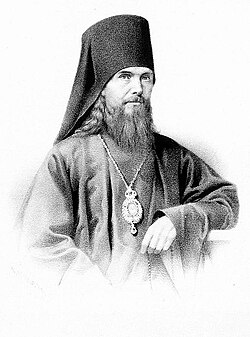Top Qs
Timeline
Chat
Perspective
January 10 (Eastern Orthodox liturgics)
Day in the Eastern Orthodox liturgical calendar From Wikipedia, the free encyclopedia
Remove ads
January 9 - Eastern Orthodox liturgical calendar - January 11

All fixed commemorations below are observed on January 23 by Eastern Orthodox Churches on the Old Calendar.[note 1]
For January 10th, Orthodox Churches on the Old Calendar commemorate the Saints listed on December 28.
Feasts
- Afterfeast of the Theophany of Our Lord and Savior Jesus Christ.[1]
Saints
- Blessed Theosebia the Deaconess (385), sister of Sts. Macrina, Basil the Great, Peter of Sebaste, and Gregory of Nyssa (385)[1][2]
- Saint Gregory of Nyssa, Bishop (395)[1][3][4]
- Venerable Ammon, monk, at Scetis in Egypt (5th century)[1][5][note 2]
- Saint Marcian of Constantinople, Presbyter (471)[1][6][7]
- Venerable Domitian of Melitene, Bishop of Melitene and Wonderworker (601)[1][8][9]
Pre-Schism Western saints
- Saint Pétrone (Petronius), monk at Lérins Abbey, then Bishop of Die in France (463)[10]
- Saint Diarmaid the Just (Dermot, Diarmis), spiritual father of St Kieran of Clonmacnois and later founder of a monastery on Innis-Clotran Island, Ireland (6th century)[10]
- Saint Tómméne (Thomian, Toimen), Archbishop of Armagh in Ireland (c. 660)[10]
- Saint Sæthryth (Sethrid), Abbess (c. 660)[10][note 3][note 4]
- Saint John Camillus the Good, Bishop of Milan, he worked against Arianism and Monothelitism (669)[10]
- Saint Agatho, Pope of Rome (681)[10][note 5]
- Saint Peter Urseolus (Pietro I Orseolo), Doge of Venice, later became a monk at the Monastery of Cuxa in Spain (987)[10][note 6]
Post-Schism Orthodox saints
- Venerable Paul of Obnora in Vologda, Abbot (1429)[1][13][14]
- Saint Macarius of Obnora in Vologda, disciple of Paul of Obnora, Abbot of Pisma Monastery (15th century)[1][15][note 7]
- Monk-martyr Ephraim, Elder of Obnora, and six monks of Obnora whose relics are incorrupt (1538)[1][17]
- Venerable Antipas of Calapodeşti (Romania), of Mount Athos and of Valaam Monastery, Hiero-Schemamonk (1882)[1][18]
- Venerable Theophan the Recluse, Bishop of Tambov (1894)[1][19][20]
New martyrs and confessors
- New Hieromartyr Zenobius Sutormin, Priest (1920)[17][21]
- New Hieromartyr Peter Uspensky, Archpriest of Radushino (Zaraisk) (1930)[1][17][21][note 8]
- New Hieromartyr Anatolius (Grisyuk), Metropolitan of Odessa (1938)[1][17][21][note 9]
- New Martyr Arsenia (Dobronravova), Abbess of the Holy Resurrection-St. Theodore Convent (Shuisk) (1939)[1][17][note 10]
Remove ads
Icon gallery
- Saint Gregory of Nyssa.
- Burial of Dometian, Bishop of Melitene
(Menologion of Basil II, 10th century) - Relic of Saint John Camillus the Good, Cathedral of Milan.
- Saint Agatho, Pope of Rome.
- Venerable Theophan the Recluse, Bishop of Tambov.
Remove ads
Notes
- The notation Old Style or (OS) is sometimes used to indicate a date in the Julian Calendar (which is used by churches on the "Old Calendar").
The notation New Style or (NS), indicates a date in the Revised Julian calendar (which is used by churches on the "New Calendar"). - There are three lives of "Venerable Ammons" who excelled in holiness. One was a student of Anthony the Great. The other was a student of Abba Pambo, who cut off the monks' ear, so that he would not become a bishop. And the third built cells to house new monks who attended the hermitage. Which of the three is the saint celebrated on 10 January is unknown. We only know that all three lived in the desert and spent their lives as Venerable monks.
- Stepdaughter of Anna, King of East Anglia. She became a nun at Faremoutiers-en-Brie in France under St Fara, whom she succeeded as abbess. She was the half-sister of Sts Etheldred (Audrey) and Ethelburgh.
- "Being called to the religious state, ST. SETHRYDA retired, with her half-sister, St. Ethelburga, and her niece, St. Ercongota, to the Abbey of Faremontiers, whilst the foundress, St. Fara, or Burgundofora, was still alive. So great was the esteem, in which the English strangers were held, and so high the reputation of their holy lives, that the two sisters were successively chosen to be Abbesses, and are counted among the Saints of God."[11]
- A Sicilian from Palermo, he called for the holding of the Sixth Oecumenical Council in Constantinople in 680 against Monothelitism.
- See also: (in Russian) УСПЕНСКИЙ ПЕТР НИКОЛАЕВИЧ. Открытая православная энциклопедия "Древо" (Open Orthodox Encyclopedia "The Tree").
- See also: (in Russian) Анатолий (Грисюк). Википедия. (Russian Wikipedia).
- See also: (in Russian) АРСЕНИЯ (ДОБРОНРАВОВА). Открытая православная энциклопедия "Древо" (Open Orthodox Encyclopedia "The Tree").
Remove ads
References
Sources
Wikiwand - on
Seamless Wikipedia browsing. On steroids.
Remove ads








